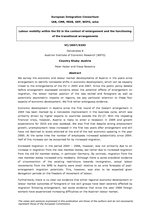Labour Mobility Study
Labour Mobility - Country Report - Latvia
Agnieszka Fihel and Zaiga Krisjane
in: Labour Mobility - Country Reports
Labour Mobility Study ,
Latvia constitutes a good example of economy of a small size, with all its consequences with regard to people's, trade's and capital's mobility. With approximately 40 thous. persons who left Latvia in the aftermath of the 2004 EU enlargement, the number of Latvian migrants has not been elevated in comparison to other sending countries. However, the intensity of the postaccession outflow could be rated among the highests in the group of NMS. The international labour mobility, together with such macroeconomic imbalances as consumption-driven economic growth, the investment-domestic savings gap and inflationary pressure, caused serious distortions in the Latvian labour market developments. The most important include substantial increase in the wage level and severe labour shortages in several economic sectors, such as administration, transport and manufacturing. Remittances sent from abroad are mostly spent on domestic consumption and, therefore, the impact of migrants' incomes seems to be of less significance to economic development. Last, but not least, due to the aging process and the so-called youth-drain, demographic forecasts reflect a real depopulation of the country, which anticipates elavated labour immigration in the near future.
Countries covered: Latvia, Baltic States
Research Areas: Labour, Migration and Income Distribution
